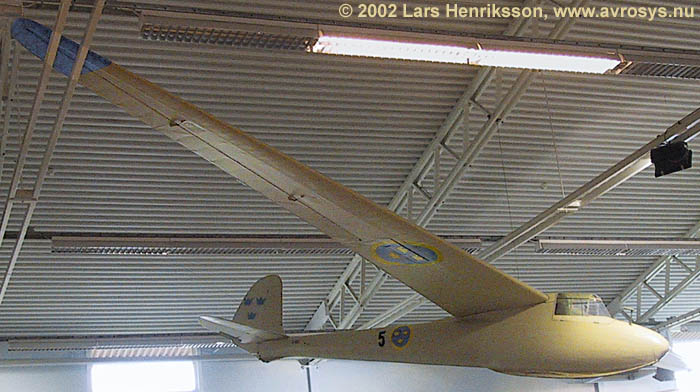|
|
||
|
Se
104 - DFS Weihe A-3 (1943-1958) |
||
| Page 1 (2) | ||
|
|
||
 |
||
|
The
DFS Weihe (”Harrier” in English) from 1938 became the standard high
performance sailplane in most European countries. As the Se 103 Kranich,
this sailplane was designed by Hans Jacobs at DFS (Deutsches
Forschungsanstalt für Segelflug (German Research Institute for Soaring
Flight). The Weihe set a lot of world records in the post-war years.
After the war, a slightly modified variant was manufactured by
Focke-Wulf. The
Weihe got the designation Se 104
in the Air Force. The 19 Weihe purchased
were manufactured by AB Flygindustri (AFI) at Halmstad. 17 of
them (Air Force numbers 8301-8317) were delivered in 1943. Two years
later, further two Se 104 were bought from the same company (8318-
8319). The
Weihe was built from wood and fabric. Instead of the gull-wing used by
other contemporary popular designs, a straight wing was chosen to give a
cheaper aircraft. The wing used a thin aerofoil section. The relatively
long fuselage had a narrow cross section to improve the flying
performance, but made the cockpit rather uncomfortable. Like the Se 103
Kranich, the glider used a jettisonable double wheel to take off and
landed on a skid landing gear. The aircraft was easy to dismount after
landing at remote places. Behind
the pilot, there was a luggage space where a 40 litres ballast tank and
oxygen bottles for flying at high altitudes could be stowed. In
1964 all wooden sailplanes in Sweden - including the Weihe - were
grounded as the glued joints of the aircraft began to get unsafe.
Photo
at top: This Se 104 is displayed at Flygvapenmuseum. It carried the
Sw/AF No 8316 and the c/n 235.
Photo
below: This Se 104, in the markings of Wing F 4 at Frösön/Östersund
must have made a record flight. It is now soaring over the ruins of
Brahehus at Lake Vättern, more than 500 km from home! Photomontage with
the help of a model Se 104 from the Museum of Soaring at Ålleberg. Length: 8,0 m. Span: 18,00 m. Height: 2,18 m. MTOW: 335 kg. Max. speed: 70 km/h. Lift/drag ratio 29:1 at 70 km/h. |
||
|
|
||
 |
||
|
|
||
|
|
||
|
|
||
|
© Lars Henriksson |
|
Updated 2010-07-11 |
|
Custom Search
|
||
